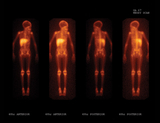Gallium Scan
What is a gallium scan?
A gallium scan is a test that detects areas of infection or inflammation in the body. It is also used to detect certain types of cancer.

We do the test by giving your child an intravenous radiopharmaceutical. This "tracer" is medicine combined with a small amount of radioactive material. It travels to the area of your child we need to see and is detected and imaged by a gamma camera.
Radiopharmaceuticals are carefully tested. The risk of side effects is extremely small. Most radiopharmaceuticals used in nuclear medicine studies give less radiation exposure than a day at the beach.
Depending on the reason for the scan, the imaging portion can take place from one to three days following the injection. It is not uncommon to have imaging done on multiple days.
What should you do prior to your child's exam?
- Your child cannot receive radiographic contrast agents 24 hours prior to the gallium scan.
- Dress your child comfortably, in clothes that are easily removed. Your child may be given a gown to change into for the procedure.
- We have a large variety of video entertainment to choose from, however, your child can also bring along a favorite movie to watch during the exam.
- You may want to bring a snack or drink for your child to have after the exam.
Note: Parents will be allowed to accompany the child into the exam room. It may be helpful to make other arrangements for siblings.
What should you expect during the exam?
- A technologist or nurse will place an IV in your child’s arm, hand or foot. Your child may feel a small pinch.
- The technologist will ask why the gallium scan is being done and will explain the study to you and your child. The technologist will inject the tracer through the IV line, then remove the IV. The technologist will tell you when to return to the department for the imaging portion of the test.
- Scanning can take place 24 hours, 48 hours, 72 hours and 96 hours after the injection. The specific imaging days depend on your child’s history. It is not uncommon to have imaging done on multiple days. The first set of images usually takes 45-90 minutes. Follow up images may not last as long. Your child will have to lie still during the imaging portion of the test.
- SPECT imaging may be necessary during this procedure.
- Young patients and those who are unable to hold still may be sedated for the delayed imaging portion of the test.
If you’d like, our child life specialists will help you prepare and support your child during the procedure. We can also arrange to have a child life specialist at your child's appointment to explain the procedure in developmentally appropriate ways and to help your child better cope with the stress of the hospital experience.
What should you do after the exam?
There are no special instructions for your child to follow when the procedure is over.
Test results
The images from your child's exam are interpreted on the same day and a report is sent to your physician's office.
Your physician may call 215-590-2584 with questions about the exam.